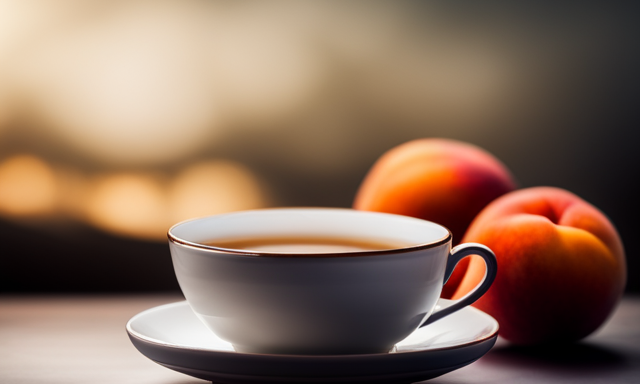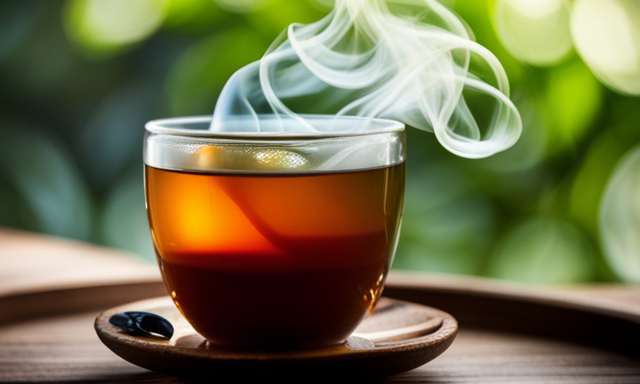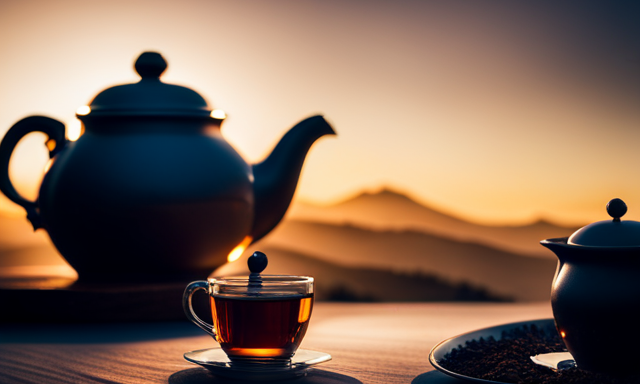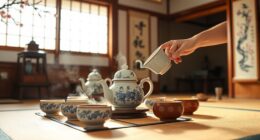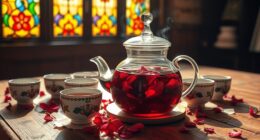To make peach oolong tea, you will need the following ingredients:
-
Oolong tea leaves: Choose high-quality oolong tea leaves for the best flavor. Look for leaves that are tightly rolled and have a rich, earthy aroma.
-
Ripe peaches: Select peaches that are fully ripe and fragrant. The sweetness and juiciness of the peaches will greatly enhance the flavor of the tea.
Now, let’s move on to the step-by-step process of making peach oolong tea:
-
Start by brewing the oolong tea: Bring water to a boil and let it cool for a few minutes to around 190°F (88°C). Place the oolong tea leaves in a teapot or infuser and pour the hot water over them. Allow the tea to steep for about 3-4 minutes, or until the desired strength is achieved.
-
Prepare the peaches: Wash the peaches thoroughly and remove any stems or leaves. Cut the peaches into slices or small chunks, removing the pit.
-
Infuse the peaches into the tea: After the oolong tea has steeped, add the peach slices or chunks into the teapot or cup. Allow the peaches to infuse into the tea for about 5-7 minutes, or until the desired level of peach flavor is achieved.
-
Strain and serve: Once the peaches have infused into the tea, use a strainer to remove the peach pieces and any tea leaves. Pour the peach-infused oolong tea into cups or mugs and serve hot.
-
Optional: Sweeten to taste. If desired, you can add a sweetener such as honey or sugar to enhance the sweetness of the tea. Stir well until the sweetener is dissolved.
Now, sit back, relax, and enjoy the delightful flavors of your homemade peach oolong tea. Savor each sip and let the combination of fruity peach and delicate oolong tea transport you to a state of pure bliss. Cheers!
Key Takeaways
- Peach oolong tea is a delicious and healthy beverage that offers numerous health benefits.
- Sweetening the tea can enhance the flavor, but it’s important to do so in moderation to avoid overpowering the natural flavors of peach and oolong.
- Experimenting with variations such as adding honey, lemon, or cinnamon can add versatility to the taste and personalize the experience.
- Serving the tea chilled over ice can provide a refreshing twist, making it an ideal choice for hot summer days.
Select the Right Oolong Tea Leaves
To select the perfect oolong tea leaves for your peach oolong tea, there are a few tips and tricks to keep in mind:
-
Consider the flavor profile you desire for your tea. Some oolong tea leaves have a more floral taste, while others have a more roasted or fruity flavor.
-
Explore different peach varieties that will complement the oolong tea. Whether it’s a juicy yellow peach or a tangy white peach, the choice is yours.
By carefully selecting the oolong tea leaves and peach variety, you can create a harmonious blend of flavors that will tantalize your taste buds.
Now, let’s move on to the next step and gather fresh peaches for our tea.
Gather Fresh Peaches
First, go on a delightful peach-picking adventure, hand-selecting the juiciest and ripest peaches for your exquisite oolong tea.
When it comes to making peach oolong tea, using fresh peaches is essential to achieve the perfect flavor and aroma. Not only do fresh peaches impart a natural sweetness to the tea, but they also offer a range of health benefits. Peaches are rich in vitamins, minerals, and antioxidants that promote overall well-being.
Additionally, they can be used in creative peach tea recipes, such as adding slices to your iced tea or blending them into a refreshing peach smoothie.
Once you have gathered your fresh peaches, it’s time to prepare your tea infuser or tea bags, ensuring that every sip of your peach oolong tea is a delightful experience.
Prepare Your Tea Infuser or Tea Bags
After gathering the fresh peaches, it’s time to get your tea infuser or tea bags ready for the next step. When making peach oolong tea, using a tea infuser or tea bags allows the flavors to infuse into the water, creating a deliciously fragrant and flavorful brew. A tea infuser is a small mesh or perforated container that holds loose tea leaves, while tea bags are pre-packaged with tea leaves inside. Both options have their benefits. A tea infuser allows for more control over the strength of the tea, while tea bags are convenient and easy to use. Choose the option that suits your preference. Now that your tea infuser or tea bags are ready, it’s time to move on to the next step of boiling water to the correct temperature.
Boil Water to the Correct Temperature
To achieve the perfect brew, start by heating water to the precise temperature for optimal infusion. The correct water temperature is crucial in bringing out the delicate flavors of peach oolong tea.
I highly recommend using filtered water to enhance the taste and clarity of your brew. Filtered water removes impurities that can affect the overall quality of your tea. As a result, you’ll experience a cleaner and more enjoyable cup of tea.
When boiling the water, aim for a temperature of around 195°F (90°C) for oolong tea. This temperature allows the tea leaves to unfurl and release their flavors gradually.
Once the water reaches the ideal temperature, it’s time to steep the oolong tea leaves, allowing their unique blend of fruity peach notes and fragrant oolong flavors to infuse perfectly.
Steep the Oolong Tea Leaves
When steeping the oolong leaves, you’ll want to savor the delicate flavors and fragrances that slowly infuse into the water. Oolong tea is known for its numerous health benefits, including boosting metabolism and promoting heart health. To steep the tea, you have various options that can enhance the taste and experience. One popular method is the traditional Chinese Gongfu style, which involves using a small teapot and multiple short infusions to extract the full flavor of the leaves. Another option is the Western style, where you can use a larger teapot and steep the leaves for a longer period of time. Whichever method you choose, the key is to find the perfect balance of time and temperature to extract the desired flavors. Once the tea is steeped to perfection, it’s time to add freshly sliced peaches for a delightful twist.
Add Freshly Sliced Peaches
Indulge yourself in the exquisite flavors of your steeped oolong tea by elegantly adorning it with slices of freshly ripened peaches. The combination of the delicate floral notes of the oolong tea with the sweet and juicy peaches creates a harmonious and refreshing beverage.
To enhance the experience, consider experimenting with different fruit combinations. While using canned peaches is convenient, using freshly sliced peaches adds a burst of natural flavor and texture.
Imagine sipping on a warm cup of oolong tea, with the juicy slices of peaches floating gently in the liquid. With each sip, you’ll taste the subtle sweetness of the peaches complementing the earthy undertones of the oolong tea. It’s a delightful blend of flavors that will awaken your senses.
Let the flavors infuse, allowing the oolong tea to absorb the essence of the peaches, creating a tantalizing fusion of tastes.
Let the Flavors Infuse
Let the flavors infuse and mingle, creating a symphony of taste that immerses you in a truly sensorial experience.
Infusing flavors in different types of tea is an art that can elevate your tea-drinking experience to new heights. The combination of delicate oolong leaves with sweet and juicy peaches in peach oolong tea results in a harmonious blend of flavors.
The oolong tea brings a subtle floral and earthy note, while the peaches add a burst of fruity sweetness. This tea not only tastes amazing but also offers numerous health benefits. Oolong tea is known for its metabolism-boosting properties, while peaches are packed with vitamins and antioxidants. Together, they create a refreshing and nourishing beverage.
Now, let’s move on to the next step: straining the tea and serving it in your favorite teacup.
Strain the Tea and Serve
After allowing the flavors to infuse, it’s time to strain the tea and serve it. This step is crucial to ensure a smooth and enjoyable drinking experience. As I strain the tea, I can already smell the enticing aroma of peaches and oolong mingling together. It’s truly a delightful combination.
Now, let’s take a moment to discuss some interesting variations of peach oolong tea recipes. For those who prefer a stronger peach flavor, you can add a few slices of fresh peach to the tea while it’s steeping. Alternatively, you can also experiment with different types of peaches, such as white peaches or donut peaches, to add a unique twist to your tea.
Aside from its delicious taste, both oolong tea and peaches come with their own health benefits. Oolong tea is known to aid in weight loss, improve heart health, and boost metabolism. Peaches, on the other hand, are packed with vitamins, minerals, and antioxidants that promote healthy skin, aid digestion, and support a strong immune system.
With the tea strained and ready to be enjoyed, let’s move on to the next step of our peach oolong tea journey: sweeten to taste, if desired.
Sweeten to Taste, if Desired
To enhance the already delightful flavor, feel free to add a touch of sweetness to your cup of peach oolong tea. This will allow you to savor each sip with a hint of indulgence. Adjusting the sweetness level is a personal preference, so add sweetener gradually, tasting as you go.
Some popular options for sweetening your tea include honey, agave syrup, or stevia. Keep in mind that oolong tea has its own natural sweetness, so you may not need much additional sweetener. Adding too much sweetener can overpower the delicate peach and oolong flavors, so remember that moderation is key.
In addition to the satisfying taste, peach oolong tea also offers numerous health benefits. It contains antioxidants and may even provide support for weight management. So, go ahead and sweeten your tea to your liking, and get ready to enjoy your homemade peach oolong tea experience.
Enjoy Your Homemade Peach Oolong Tea
Now that you’ve sweetened your peach oolong tea to your liking, it’s time to sit back, relax, and enjoy your homemade creation. There’s something incredibly satisfying about sipping on a warm cup of peach-infused oolong tea that you made yourself. The flavors of the juicy peaches and the delicate oolong leaves blend together harmoniously, creating a soothing and refreshing beverage.
To fully appreciate the benefits of homemade peach oolong tea, here are three ways to enhance your experience:
-
Savor the aroma: Take a moment to inhale the fragrant aroma of the tea before taking your first sip. Close your eyes and let the scent transport you to a serene peach orchard.
-
Experiment with variations: Don’t be afraid to explore different variations of peach oolong tea recipes. Add a hint of honey, a squeeze of lemon, or even a sprinkle of cinnamon to discover your favorite combination.
-
Serve it chilled: For a refreshing twist, refrigerate your peach oolong tea and serve it over ice. The coolness will complement the fruity flavors perfectly, making it an ideal beverage for hot summer days.
Indulge in the delightful homemade peach oolong tea and let its soothing qualities and versatile taste captivate your senses.
Frequently Asked Questions
How do I select the right oolong tea leaves?
Selecting the right oolong tea leaves is like finding a soulmate. Each type has its own unique flavor profile and aroma, from floral and fruity to toasty and earthy. Experiment and explore to find your perfect match.
What should I do if I can’t find fresh peaches?
If fresh peaches are unavailable for making peach oolong tea, there are substitute options. Consider using canned peaches, peach puree, or even alternative fruits like apricots or nectarines to achieve a similar flavor profile.
How long should I steep the oolong tea leaves?
Determining the ideal steeping time for various teas is an art. It involves considering factors like tea type, leaf size, water temperature, and personal preference. Steeping time greatly affects the flavor and aroma of tea, so experiment to find your perfect brew.
Can I use a different sweetener instead of sugar to sweeten the tea?
Yes, there are several alternatives to sugar that can be used to sweeten tea. Some options include honey, stevia, and agave syrup. These alternatives can provide health benefits such as reducing calorie intake and regulating blood sugar levels.
How should I store any leftover peach oolong tea?
To preserve the flavor of leftover peach oolong tea, store it in an airtight container in the refrigerator. This will help maintain its freshness and prevent any unwanted flavors from seeping in.
Conclusion
In conclusion, making peach oolong tea is a delightful and refreshing experience. By selecting the right oolong tea leaves and using fresh peaches, you can create a flavorful blend that will tantalize your taste buds.
With the correct steeping and infusion process, the tea will be bursting with the essence of peach. Straining the tea and sweetening to taste adds the final touch.
So, sit back, relax, and transport yourself to a sunny peach orchard with each sip of this homemade concoction. Cheers to the perfect cup of peach oolong tea!

